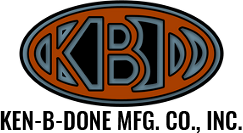FAQs
Ken-B-Done MFG. CO., Inc.
What pricing can I expect from Ken-B-Done?
Ken-B-Done charges $85 per hour during standard business hours. After-hours services, such as emergency electrical repairs, are billed at $125 per hour. The total cost varies depending on the specific job requirements and duration.What sets Ken-B-Done apart from the competition?
Ken-B-Done distinguishes itself by utilizing American-made parts to maintain lower costs and providing swift in-house machine shop services at your location.How many years of experience does Ken-B-Done have?
Established in 1998, Ken-B-Done boasts over 60 years of combined experience. Our expertise covers a wide range of woodworking equipment services, including electrical panel upgrades, on-site machine maintenance, repairs, and preventative maintenance.What can be done if a machine or spindle has a vibration?
To address machine or spindle vibration, several steps can be taken: ensure proper machine leveling, enhance machine rigidity, verify spindle alignment, replace bearings if necessary, or consider spindle replacement as a last resort.What can be done if the dust collection system is losing suction?
To improve suction in a dust collection system, consider balancing air ducts, installing blast gates, ensuring adequate air supply, and modifying pipes to increase CFM (cubic feet per minute) airflow.What happens if your compressor runs too much?
Excessive compressor operation may indicate water infiltration through damaged fittings or lines, incorrectly sized pipes, or a need for compressor servicing.Why does a wide belt sander belt not last long?
A wide belt sander's belt may wear prematurely due to improper setup, uneven sanding heads, or damaged rolls and platen bars.Why is it important to know how to run and operate your woodworking machine or any piece of equipment?
Understanding the operation of woodworking machines is crucial for employee safety, product quality, machine maintenance, and maximizing equipment capabilities.Why is it important to do an OSHA lockout/tagout?
OSHA lockout/tagout procedures are essential for worker safety, identifying power sources, preventing accidents, and ensuring machines remain inactive during maintenance or repair work.
